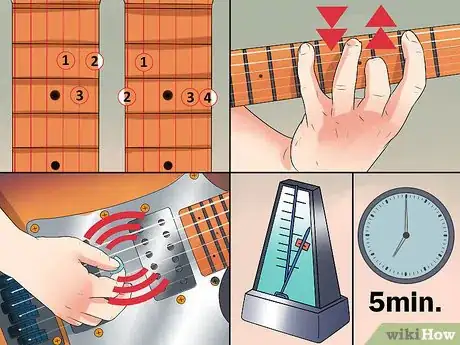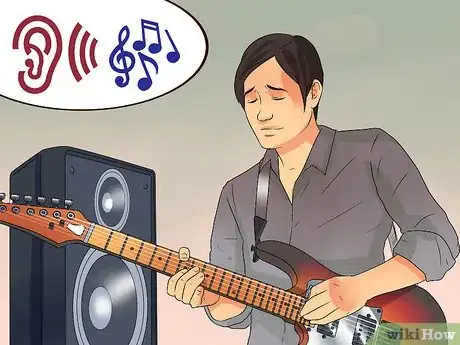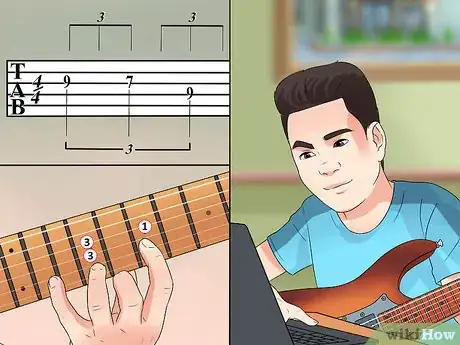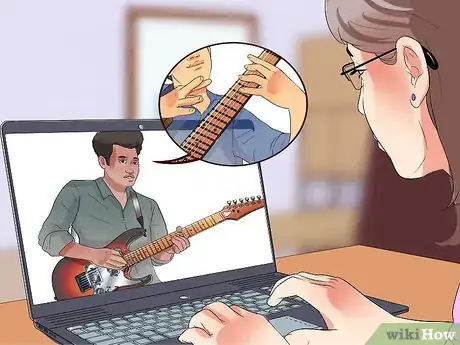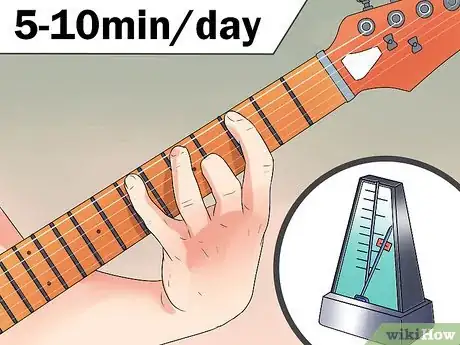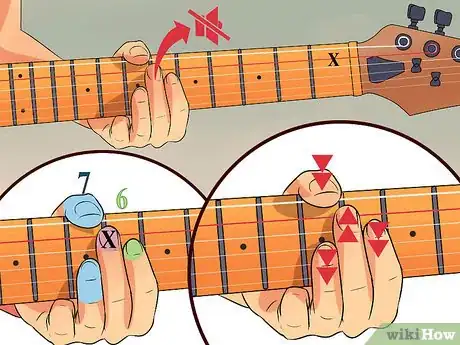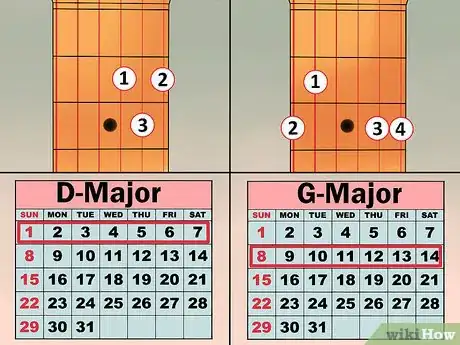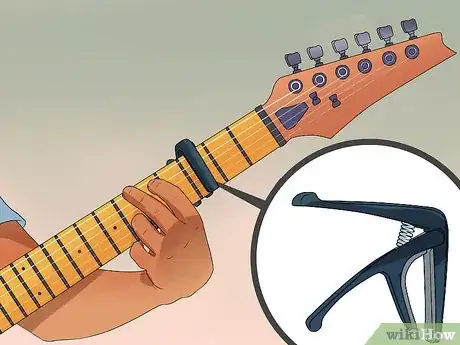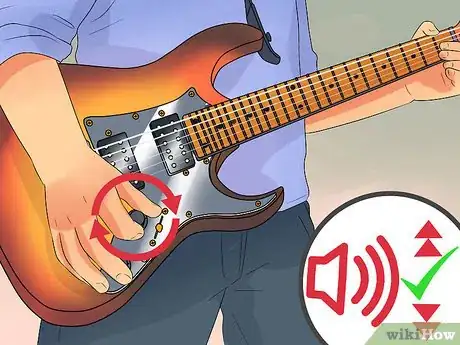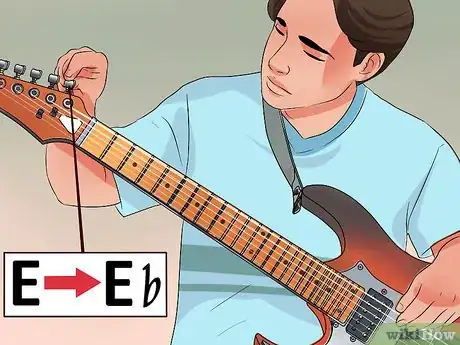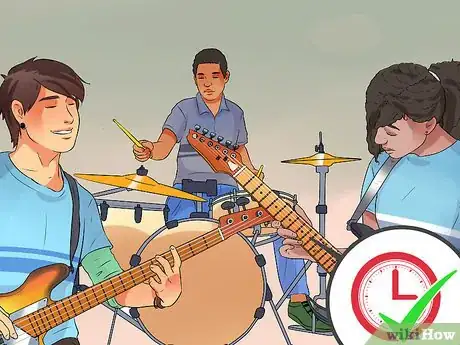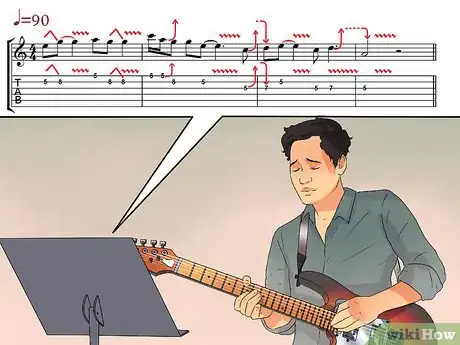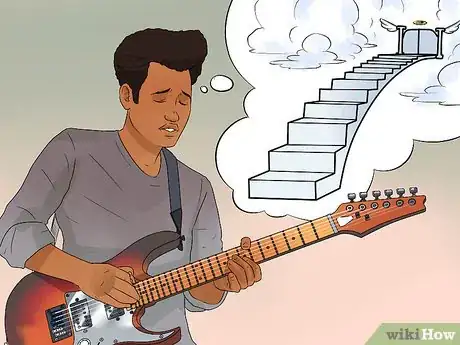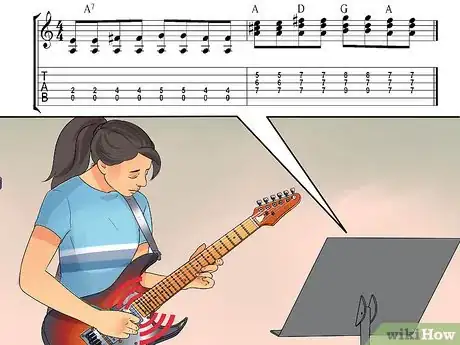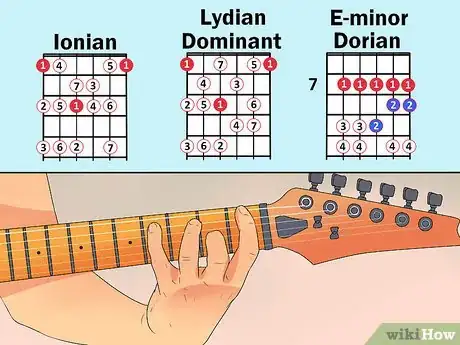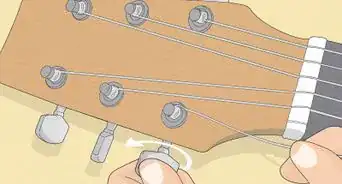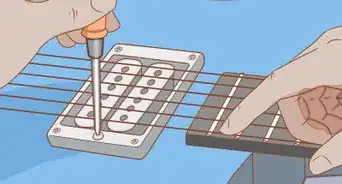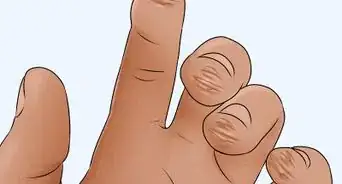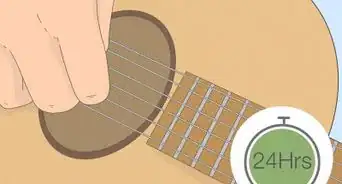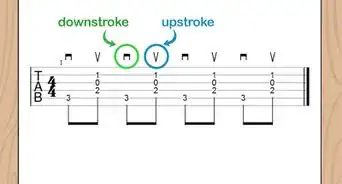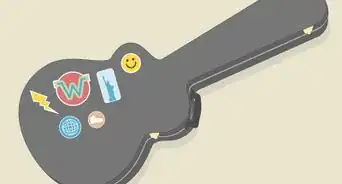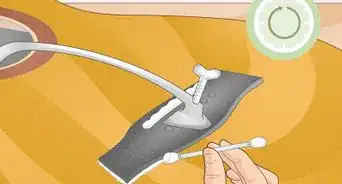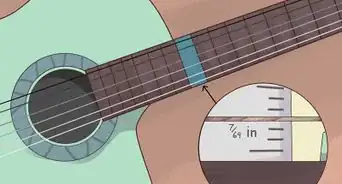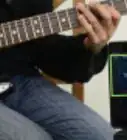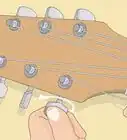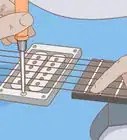This article was co-authored by Carlos Alonzo Rivera, MA. Carlos Alonzo Rivera is a guitarist, composer, and educator based in San Francisco, California. He holds a Bachelor of Arts degree in Music from California State University, Chico, as well as a Master of Music degree in Classical Guitar Performance from the San Francisco Conservatory of Music. Carlos specializes in the following genres: classical, jazz. rock, metal and blues.
There are 10 references cited in this article, which can be found at the bottom of the page.
wikiHow marks an article as reader-approved once it receives enough positive feedback. In this case, 94% of readers who voted found the article helpful, earning it our reader-approved status.
This article has been viewed 112,458 times.
A good guitarist means a lot of things to a lot of different people, but there is one thread that joins every great guitarist who ever lived: practice. That said, there are better ways to practice than others. Dedicated time to the guitar and an open, curious mind is all you really need to be a good guitarist, so grab your axe and start jamming with authority.
Steps
Improving General Guitar Play
-
1Dedicate time to practice guitar every day. If you want to be a good guitar player, you need to practice as much as you can.[1] Study after study has shown that regular, consistent practice is far more effective than big chunks here and there. Try to aim for at least 6-7 days of practice a week. That said, not all practice is created equally, and the following steps will help you make the most of your time each day you sit down.
- Practice should always be focused. That means all your mental energy is on guitar, not practicing with the TV in the background.
- Don't try to learn five new techniques a day -- it's much better to perfect 1-2 at a time.
- The more time spent practicing, the better you'll be. This is the most important thing you can do to be a good guitarist.[2]
-
2Spend time each day on the "boring" technical skills necessary for good guitar players. Shredding an incredible solo is not some skill that is trained on its own. It is the culmination of many technical exercises and hard practice. Think of the following exercises like a painter mixing up her paints -- these are the small but essential skills needed to create your art on stage. Consider just 5 minutes of the following exercises each time you practice:
- Running up and down through all of your scales.
- Learning 1-2 new chords and strumming them to a metronome
- Repeated picking exercises (search online and find your favorites)
- Speed-picking practice (alternating picking, downstrokes only, and sweeping)
Advertisement -
3Try to teach yourself your favorite songs by ear. Learning by ear is when you teach yourself a song just by listening to it. Before the internet, this was one of the only ways to learn a song, but there is more to the activity than just memorizing the notes. Learning by ear trains you to understand the guitar intuitively -- instead of thinking about what note needs to come up, you start to think about what notes will sound right before your even play it. You ear and your fingers become synced up much more smoothly.
- When learning by ear, work in small sections. Get a few notes perfectly right, then slowly add more.
- Trying to get chords right is difficult, but just work slowly. Figure out all of the root notes first, then try to determine what types of chords fit into the song.[3]
-
4Learn to read tablature ("tab"), the most common written form of guitar music. Tablature, or guitar tab, is a simple and intuitive way to write out guitar parts. You'll see six lines, much like a musical staff, with numbers on each line. The six lines correspond to your six strings, with your heavy E string on the bottom and your thinnest e string on the top. The numbers tell you which fret on that string to play, and you read from left to right. Thus, the following tab would tell you to "play the 3rd string, 2nd fret, then play an A minor chord:"
- |e|--------|-------------|
- |B|--------|------1------|
- |G|------ -|------2------|
- |D|---2---|------2------|
- |A|--------|------0------|
- |E|--------|-------------|
-
5Supplement your practice with music theory to expand your range across the guitar. Music theory may seem dull and boring, but it actually opens up thousands of new ideas, scales, and chords for you to use. Think of it this way -- would you rather have to memorize which chords and scales go with which, or would your rather of the blueprints to create any song you can imagine? Music theory, of course, is a huge field, but some good places to start include:
- The circle of 5ths.
- Major and Minor scale composition
- The use of "modes."
- Common chord progressions.
-
6Refine the tone of your guitar to truly shine on stage. While not nearly as important as technical practice and skills, good guitarists know that what they play is only part of the battle. How your guitar actually sounds, whether acoustic or electric, will help shape your tone and personal style, so take some time to research and experiment with the guitar, amp, pedals, and strings that work for you.
- String gauge is an easy way to change your tone -- thicker strings sound deeper, with more bass, while thinner strings sound high and bright.
- If you're an acoustic guitarist, the size of the guitar's body is the major factor in changing tone. Luckily, most music shops will let you test any guitar you want before buying.
- Electric guitarists have the most freedom, as you can tinker with effects pedals and amp combinations to perfectly refine your sound.
-
7Push yourself to learn new styles and songs outside your comfort zone. Good music is good music no matter what genre it is, and the best guitarists know that inspiration can come from anywhere. Different types of music use chords, scales, and rhythmic ideas that you may never think of, but can open up wholly new avenues as a guitarist:
- Drop the pick and play with your fingers. A pick may seem necessary, but guitar gods like Mark Knopfler and Jeff Beck prove otherwise.
- Cover a few songs in a genre you don't normally play -- what does it sound like "converted" to your favorite style of music?
- Try to figure out the parts for other instruments, like trumpet solos or bass lines, to get a fresh perspective of melodic composition.
- If you're a lead player, write some rhythm parts (or vice versa).
-
8Take lessons, play with a more experienced guitarist, or enroll in an online class. Take classes, get a book, watch an instructional video, or join one-on-one lessons -- whatever teaching style you prefer, seek some outside guidance to kick-start your learning. It seems obvious, but you cannot teach yourself what you don't know. A dedicated teacher or set of lessons will help you improve much more quickly than you can on your own.
- No matter what avenue you take, make sure you're still enjoying yourself. A teacher is no good for your development if they take all of the fun away.[4]
Improving as a Rhythm or Solitary Guitarist
-
1Push yourself past your most common strumming patterns. If you've been playing guitar for any period of time, you'll likely start to notice that you naturally fall into the same strumming patterns each time you play or write a song. The best way to avoid this is to try and duplicate strumming patterns from your favorite artists, pushing yourself to widen your rhythmic tool belt.
- Can you mix some single notes into your strumming? For example, a very country-western technique is to pick the root note, then strum the chord separately right afterwards.
- Remember to strum both up and down when playing.
- How can you use muted strings (by lifting your fingers lightly off the frets) to get a percussive sound in your strumming? Check the Violent Femmes for good examples.[5]
-
2Practice daily with a metronome, percussionist, or both. A rhythm guitarist, it goes without saying, needs to be able to stay in rhythm. The problem is that a guitarist's primary training is in melody, as drummers generally provide the rhythm for you to follow along to. However -- the ability to stay perfectly and precisely in time separates the amateurs from the pros, as perfect rhythm has an indescribable ability to make people dance.
- Spend at least 5-10 minutes a day on a metronome, if not the entire practice session.
- Always start at a pace where you can play the notes perfectly instead of rushing through. Gradually up the tempo as you get faster.
- Many metronomes can be set to click off for a few beats, forcing you to stay in time on your own before they come back in. This is a great way to test yourself.[6]
-
3Learn to dampen bum notes to clean up your chords. Many times, especially with electric guitars and distortion, playing too many notes at once can sound muddled or messy. Many jazz chords require skipping strings in the middle of the chord to sound correct. Great guitarists pull this off but using the pads of their fingers to dampen the strings below the strings they're fretting. For example, the following jazz chord is formed by using the bottom of your middle finger to mute the A string, allowing you to freely strum all six strings without the A sounding out:
- |e|----7----|
- |B|----7----|
- |G|----7----|
- |D|----6----|
- |A|----x----|
- |E|----7----|
-
4Teach yourself 1-2 new chords a week. Ideally, you want chords that you can play with chords you already know, which helps you practice transitioning from one to the other. Dig deep into every chord you can find, from simple power chords to complex jazz shapes. To effectively learn a chord:
- Practice forming the shape from nothing. Take your hand off the guitar, then place it down in the chord shape. Repeat until it feels automatic.
- Practice getting to the chord from other chord shapes.
- Play or learn a song with the chord in it.
- Review your new chords each day until memorized.
-
5Use capos to place difficult-to-sing songs into your vocal range. A capo simply shortens the neck of the guitar, allowing you to play open chords starting at any point. This means you can change the key of a song without actually changing the shape or order of any of your chords, allowing you to play the song in any key you can sing it. Effective capo use is essential for a rhythm guitarist or singer/songwriter.
-
6Learn the value of groove by paying close attention to bass and drum techniques. As part of the rhythm section, you are responsible for keeping the song grooving both melodically and rhythmically. If you're in a band, you need to be locked into these other musicians so that you're always in time, hitting each note in unison to give the song power. If you're playing all alone, it's twice as important to get this groove down:
- Learn the basics of bass guitar and/or drums to get more in touch with the tempo and timing aspects of rhythm guitar.
- Focus on playing every note together as a rhythm section. This perfect synchronicity is the essence of a good groove.
- When playing alone you have a lot more freedom with rhythm. The best way to "groove" is to know the song so well it's automatic, letting you feel the energy of the song and audience instead of thinking about the next chord.[7]
-
7Use dynamics, or volume control, to create unique and captivating rhythm parts. Work on a smooth transition from dead silence to powerful strumming, or picking individual notes in between fuller chords. Your ability to modulate tone and volume is a great way to create tension and release in a song, building drama and energy.
- When playing with a band, try to sync up with the drummer. When he takes some volume off, you should too.
- If playing alone, use volume control to manipulate the energy of the song. Try starting slow, then building up to a triumphant or climactic song. See John Butler's "Oceans" for a good example.
-
8Experiment with alternate tunings. New tunings open up new sounds, new chords, and can make certain chords or progressions far easier to play. A good way to start is by learning some famous songs in other tunings -- the Led Zeppelin ("Hey Hey What Can I Do") & Rolling Stones ("You Can't Always Get What You Want") catalogs particularly good places to start. Guitarists Jimmy Page and Kieth Richards both lean heavily on alternate tunings.
- Start with open tunings, which are when the guitar hits a chord without holding down any frets. This allows you to play more open notes, giving the whole song a brand new texture.
- Even dropping your low-E string a half step will give you a slightly richer, deeper tone overall, as seen in Led Zeppelin's "Hey Hey What Can I Do."[8]
Improving as a Lead Guitarist
-
1Make sure your lead lines service the song, not overshadow it. The best lead guitarists don't just know what to play, but when to play it. In particular, lead lines tend to muddle up singing, and so most guitarists tend to fill in the gaps between words instead of playing on top of them. Your goal, always, is to be a part of the song, not to try and stand out on top of it. Other strategies to consider include:
- Letting your lead lines mimic the song, such as playing the melody the singer sings or synchronizing with the bass line.
- Using lead lines to transition in and out of intros, choruses, bridges, etc. instead of constantly playing them.
- Making each note count instead of seeing how many notes you can play.
-
2Pay attention to a note's expression, not just the notes themselves. For a masterclass in expression, listen to B.B. King. On paper, many of his solos don't seem that impressive. But live, when you hear the incredible emotion and tone he drips on every note, you realize why he is one of the greatest to ever live. If you focus on making each note compelling and enjoyable your solos will become exponentially better. Remember that the guitar is a physical instrument-- get physical with the strings:
- Vibrato, or shaking a note back and forth, is a great way to drag a note out artfully.
- Bending into and out of notes allows to literally "manhandle" the note into the tone you want.
- Slides let you move gracefully around the fretboard, gliding notes into one another
- Hammer-ons and pull-offs help your play quick sets of notes with extra emphasis and speed.[9]
-
3Build solos like stories instead of just tossing out technical fireworks. It may sound cliche, but Jimmy Page's "Stairway to Heaven" solo is a masterclass in how to build a compelling, gripping guitar solo. Think like a storyteller -- with rising action, a climax, and a resolution. "Stairway's" solo starts slow, building power until it crescendos in the blistering licks the song is known for.
- Don't ever play your best stuff first -- save it for the climax.
- Restraint is key. Remember that what is hardest to play is not always what sounds best.
- Find a "home base" lick to keep coming back to if you get lost in the scale. This gives your solo a recognizable structure or theme as well.
- Tension is caused by contrasts -- a fast section sounds far quicker when played after a slow one.
-
4Start improvising to your favorite songs and backing tracks. Even if the lines and solos in your band's songs are usually written in advance, improvisation is one of the top ways to explore the fretboard and expand your musical creativity. Improvising is, naturally, a personal effort, so you can and should go about it however you'd like. Some good ways to get started include:
- Look up backing tracks on YouTube, like "Blues in A-minor," to play basic scales along to.
- Learn your favorite solos, then experiment with rearranging the notes in new ways over the same song.
- Get a guitar partner, make up a quick chord progression, and trade solos back and forth, alternating the rhythm player.
-
5Study rhythm guitar to immerse yourself in chords, structure, and solo ideas. One of the biggest mistakes a lead guitarist can make is thinking they're better than or above the rhythm player. Nothing is further than the truth, as the best lead players must know chords inside and out. Think of it this way -- a chord is simply a collection of single notes all played at once, meaning all of these notes are plum for the picking in lead lines. If you know the rhythm section backward and forwards you'll be able to write unique, blistering lead lines and solos to mesh with it.
- It's generally good practice to be able to play the rhythm section proficiently before crafting lead lines.[10]
-
6Jam with other musicians and guitarists. Music is a shared art form and one that can be learned much faster with others. You pick up tricks, share and receive new chords or scales, and learn to play on the edge of your seat. Playing with others is the closest you can get to being on stage while still practicing. Furthermore, surrounding yourself with better musicians is the fastest way to get better yourself. When jamming, remember to:
- Play both rhythm and lead. No one likes a solo hog.
- Ask questions if you're confused. Learn the chords in the beginning, not when it's your partner's chance to solo.
- Play with the other instruments, not on top of them. When everyone is playing together, everyone sounds better.[11]
-
7Dive into modes -- slightly different scale forms with specific moods and tones. A mode is simply a set of notes in the major or minor scale that you highlight instead of playing the entire scale. In a sense, they are entirely new scales to play, though they take a little study to master. Pick one below that sounds good and look it up online. Each mode emphasizes certain notes to get totally different moods and styles:
- Ionian -- your basic major scale
- Dorian -- a bluesy minor key sound.
- Phrygian -- a Spanish-sounding minor mode
- Lydian -- very close to the major scale, but with a slight cool-jazz tint
- Mixolydian -- a bluesy major key sound
- Aeolian -- an almost identical minor key, but playable over major chords
- Locrian -- very unstable sounding mode, sometimes used in death metal and atonal jazz.[12]
Community Q&A
-
QuestionShould I practice metal songs that require distosion with my acoustic guitar or should I buy an electric one?
 Community AnswerA large part of metal and other "hardcore" guitar lines is finding a way to mimic the tone and sound. While you can practice technical skills on a guitar, you'll need to grab an electric if you want to seriously practice genres like metal or punk.
Community AnswerA large part of metal and other "hardcore" guitar lines is finding a way to mimic the tone and sound. While you can practice technical skills on a guitar, you'll need to grab an electric if you want to seriously practice genres like metal or punk. -
QuestionI have my first class in 3-4 days. How long until I can play full songs?
 Alyssa SilverglassCommunity AnswerIt depends on how fast you learn and how much you practice. Take your time, and don’t rush yourself. You won’t be able to play full songs right away. It will take a few months of hard work, at least.
Alyssa SilverglassCommunity AnswerIt depends on how fast you learn and how much you practice. Take your time, and don’t rush yourself. You won’t be able to play full songs right away. It will take a few months of hard work, at least. -
QuestionI am right into Blues music. Never played guitar before and don't know where to start. What should I buy first, acoustic or electric?
 Espinoza ChristianCommunity AnswerBlues music is typically paired with an electric guitar, and more specifically a hollow body like the ES Les Paul. Of course, if you do not own the equipment to accommodate this style, you can use an acoustic but most blues components sound much better when you use electric. Also, if you are diving right into blues, learn pentatonic scales, so it's easier to improvise and really dig deep into that energy that comes from playing blues.
Espinoza ChristianCommunity AnswerBlues music is typically paired with an electric guitar, and more specifically a hollow body like the ES Les Paul. Of course, if you do not own the equipment to accommodate this style, you can use an acoustic but most blues components sound much better when you use electric. Also, if you are diving right into blues, learn pentatonic scales, so it's easier to improvise and really dig deep into that energy that comes from playing blues.
Warnings
- There are no shortcuts to becoming a good practice. The one and only road to success is through dedicated practice.⧼thumbs_response⧽
Things You'll Need
- Guitar
- Guitar tuner
- Metronome
References
- ↑ Carlos Alonzo Rivera, MA. Professional Guitarist. Expert Interview. 27 August 2019.
- ↑ http://www.selfgrowth.com/articles/top-5-causes-of-slow-progress-on-guitar-and-how-to-get-better-fast
- ↑ https://www.guitarnoise.com/lessons/happy-new-ear/
- ↑ https://tomhess.net/Articles/CanYouReallyBecomeAGreatGuitarPlayer.aspx
- ↑ http://www.creativesparkguitar.com/practice-tips-how-to-get-really-good-as-fast-as-possible/
- ↑ http://www.creativesparkguitar.com/practice-tips-how-to-get-really-good-as-fast-as-possible/
- ↑ http://www.premierguitar.com/articles/Rhythm_Rules_6_Essential_Exercises_to_Improve_Your_Groove
- ↑ http://tonereport.com/blogs/lifestyle/5-secrets-of-being-a-great-rhythm-guitarist/page/three
- ↑ https://www.ultimate-guitar.com/lessons/the_guide_to/how_to_become_a_great_lead_rock_guitarist.html
About This Article
To be a good guitar player, you’ll need to practice often and learn from other people. Practice for an hour or so every day, since you’re more likely to learn things if you do them frequently. Focus a lot of your time on learning the basics, like chords and scales, so you feel totally confident with them. Don’t try to learn too many techniques at once, since this will overwhelm you. Instead, focus on learning 2 or 3 chords or teaching yourself one of your favorite tunes by ear. Look for your favorite songs on guitar databases online so you can learn to play them. You can also watch videos on how to perform specific techniques, such as switching between difficult chords or playing a particular solo. If you feel like you’re struggling to improve your technique, try taking lessons or playing with someone whose better than you so you can pick up something new. For tips from our Music co-author on how to be a great lead guitarist, keep reading!


